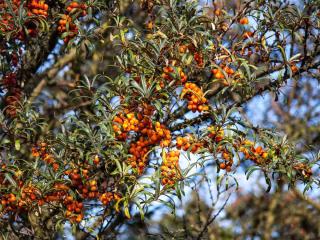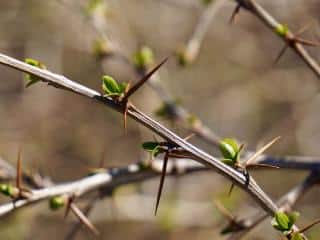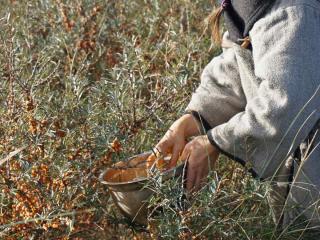

Sea buckthorn is a thorny shrub worth checking out for its numerous vibrant-colored fruits. They’ll brighten up your garden in winter.
Sea buckthorn key facts:
Latin name: Hippophae rhamnoides
Family: Elaeagnaceae
Type: shrubby tree
Foliage: deciduous
Height: 10 to 16 feet (3 to 5 m)
Exposure: sunny
Soil: light, well-drained, neutral to alkaline pH
Hardiness: hardy – Blooming: spring – Fruiting: fall, winter
 Hippophae rhamnoides is a dioecious species, meaning there are male and female plants. To get fruits, it’s a good idea to plant one male for every 5 or 6 females.
Hippophae rhamnoides is a dioecious species, meaning there are male and female plants. To get fruits, it’s a good idea to plant one male for every 5 or 6 females.
Sea buckthorn foliage is very narrow with a grey-green color.
Fruit shows up in early fall and its red-orange color pops even more when leaves fall. These berries are edible, with a sweet and lovely tangy flavor.
It’s often confused with firethorn due to similar phonetics and appearance, but they are indeed different shrubs.
→ Caution: Italian buckthorn, an unrelated shrub that unfortunately goes by a similar name, has toxic berries.
Sea buckthorn, or argousier as we say in French, thrives in all soil types, as long as it’s lightweight and draining. If possible, place it in full sunlight year-round, but it’ll tolerate some shade.
For a fruitful harvest, plant one male for every 5 or 6 females. You’ll thank us later.
Drought-resistant and vigorous, sea buckthorn doesn’t mind whether you plant it in spring or autumn.
 Dig a wide and deep planting hole. No need to measure, just make it spacious.
Dig a wide and deep planting hole. No need to measure, just make it spacious. No need for extra pampering here. Only prune your sea buckthorn when you feel like it:
No need for extra pampering here. Only prune your sea buckthorn when you feel like it:
Create new sea buckthorn plants by layering, cutting (softwood in August or hardwood in winter) or sowing.
Impressively hardy, Hippophae rhamnoides gives pests the cold shoulder and shows no sign of disease.
With its ground-covering root system, sea buckthorn makes it its duty to hold together soil on unstable slopes. Salt and sea spray? No problem, which makes it a superstar for jazzing up a coastal garden.
Want to fully enjoy those bright red-orange fruits in winter? Pair your sea buckthorn with trees or shrubs boasting bright decorative wood, like a colorful bark dogwood (example: Cornus sericea), or yellow wood white willow (Salix alba).
 Typically, you’d harvest sea buckthorn berries around October, preferably after the first frost. Picking them isn’t exactly a walk in the park due to the tree’s thorns. But shaking the branches over a ground cloth, will let you collect these tough-to-reach fruits with ease.
Typically, you’d harvest sea buckthorn berries around October, preferably after the first frost. Picking them isn’t exactly a walk in the park due to the tree’s thorns. But shaking the branches over a ground cloth, will let you collect these tough-to-reach fruits with ease.
After the harvest, feel free to enjoy the berries raw, or try them with yogurt or cereal. They also keep well in juice, syrup, jam, or even frozen.